Historic cemeteries offer unique wildlife viewing opportunities you won’t find elsewhere in urban areas. These peaceful sanctuaries create diverse habitats with mature trees, varied terrain, and minimal disturbance that attract rare birds, mammals, and pollinators. You’ll witness seasonal migrations, discover species that have retreated from developed areas, and experience the fascinating intersection of cultural heritage and natural ecosystems. The quiet pathways between monuments reveal nature’s remarkable resilience in unexpected places.
The Unexpected Biodiversity of Historic Burial Grounds
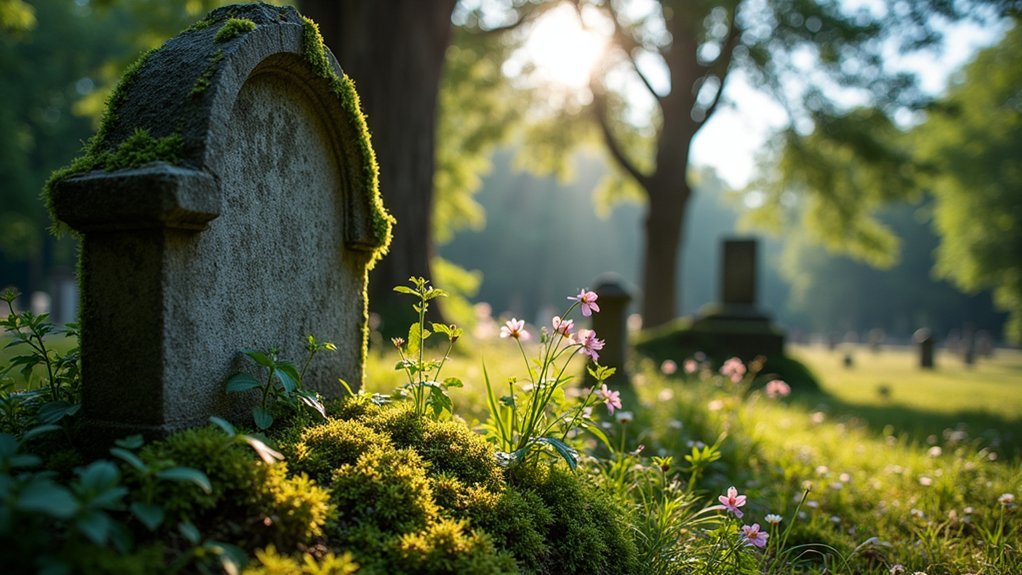
While many visitors come to historic cemeteries seeking connections to the past through tombstones and monuments, they’re often surprised by the vibrant ecosystem thriving among the graves.
These peaceful grounds serve as accidental wildlife sanctuaries, preserving pockets of nature in otherwise developed areas.
During historic cemetery tours, you’ll discover how unique natural features like ravines and undulating terrain create diverse microhabitats.
Native trees, flowers, and shrubs provide food and shelter for birds, insects, and small mammals that have made these grounds their home.
This rich biodiversity enhances your cemetery experience, offering moments of wonder as you observe wildlife amid the historical markers.
You’re witnessing two preservations at once—cultural heritage and natural environment—coexisting in remarkable harmony.
Silent Sanctuaries: Cemetery Ecosystems Explained
As you wander through historic burial grounds, you’re actually exploring delicate ecosystems that have evolved over centuries with minimal human interference.
Historic cemeteries function as green oases within urban landscapes, offering refuge to diverse wildlife when surrounding areas face development.
The unique topography of these sacred spaces—with their ravines and rolling aesthetics—creates varied microhabitats supporting birds, insects, and small mammals.
You’ll notice how trees, flowers, and shrubbery form networks of natural resources that sustain these creatures year-round.
These silent sanctuaries serve an important ecological purpose as wildlife corridors, connecting fragmented habitats across cities.
When you visit, you’re witnessing the beautiful intersection of cultural heritage and natural processes—a reminder that these spaces preserve both human stories and ecological relationships essential to urban biodiversity.
Dawn Chorus Among the Headstones
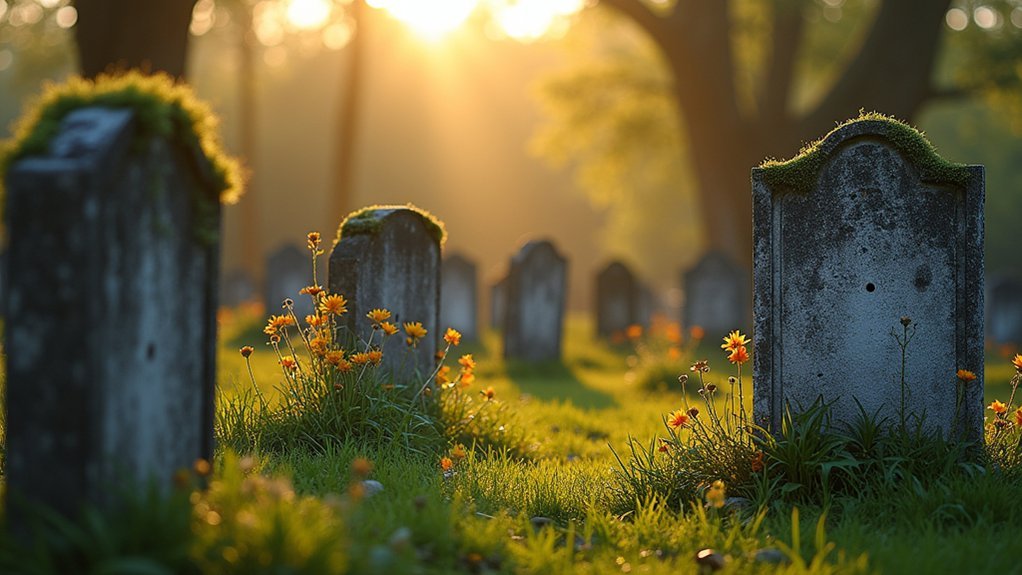
Have you ever experienced the magical symphony that unfolds in historic cemeteries at daybreak? As the first light breaks, birds create a dawn chorus that fills these peaceful grounds, offering you a unique blend of history and nature.
When you visit historic cemeteries in the early morning, you’ll find yourself surrounded by diverse bird species singing among varied trees, flowers, and shrubs. This rich ecosystem invites visitors to explore both the historical monuments and the vibrant wildlife that calls these sanctuaries home.
The tranquil setting, combined with melodious birdsong, creates perfect conditions for mindfulness and reflection.
You’ll discover that morning cemetery tours aren’t just educational journeys through the past—they’re also opportunities to connect with nature’s rhythm in surprisingly serene surroundings.
Seasonal Migration Patterns in Cemetery Landscapes
Throughout the changing seasons, historic cemeteries transform into vital waypoints for migratory birds seeking refuge during their long journeys.
You’ll notice diverse species appearing and disappearing as the months progress, making each cemetery visit a unique wildlife observation experience.
The varied landscapes within these grounds—from ravines to rolling hills—create perfect stopovers for birds following seasonal migration patterns.
Trees and shrubs flourish throughout cemetery grounds, providing essential food sources and shelter for traveling wildlife.
As vegetation changes with the seasons, so does the wildlife population.
Spring might bring nesting songbirds, while fall introduces different migratory species passing through.
These peaceful, often overlooked sanctuaries offer you an exceptional opportunity to witness nature’s rhythms while exploring historic grounds—connecting you to both natural heritage and human history.
Rare Species Sightings in Urban Memorial Parks
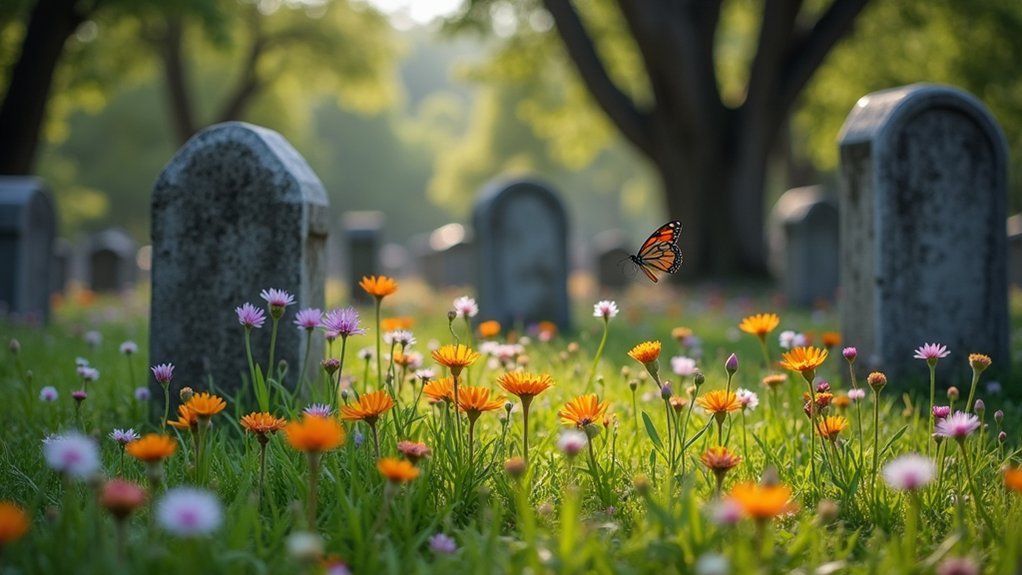
You’ll be amazed at the ecological sanctuary niches found within historic cemeteries, where undisturbed grounds often harbor rare plant and animal species that have disappeared elsewhere in the city.
These urban biodiversity hotspots benefit from decades of minimal intervention, creating microhabitats where endangered pollinators, uncommon birds, and native flora can thrive away from development pressures.
The undisturbed habitat advantages of memorial parks offer you a unique opportunity to spot species that have otherwise retreated from metropolitan environments, making cemetery tours as valuable for naturalists as they’re for history enthusiasts.
Ecological Sanctuary Niches
Nestled within the hustle of urban landscapes, historic cemeteries serve as unexpected havens for wildlife seeking refuge from concrete and glass. At Glenwood Cemetery, you’ll discover a vibrant ecosystem thriving among memorial stones.
These ecological sanctuaries harbor diverse habitats that support rare species often absent from surrounding urban areas.
As you explore the winding walkways, you’ll notice how thoughtfully designed curves create natural corridors for wildlife movement. The varied terrain, including ravines connecting to Buffalo Bayou, forms distinctive microhabitats that foster biodiversity.
Trees, flowering plants, and shrubbery attract a surprising array of birds, insects, and small mammals.
These green spaces don’t just honor human history—they actively preserve natural heritage by maintaining essential ecological niches within our cities’ environmental tapestry.
Urban Biodiversity Hotspots
Despite their solemn purpose, historic cemeteries like Glenwood have emerged as unexpected biodiversity hotspots within our urban landscape.
You’ll discover these memorial grounds serve as essential wildlife conservation zones, harboring species that struggle to thrive elsewhere in concrete-dominated cities.
- Rare migratory birds often use these green oases as stopover points during seasonal journeys
- Native pollinators flock to the diverse flowering plants, many of which are heritage varieties
- Mature tree canopies provide nesting sites unavailable in newer developed areas
- Small mammals establish territories in the relatively undisturbed grounds
- Endangered plant species sometimes find refuge in these protected spaces
When you visit historic cemeteries through guided tours, you’re not just experiencing history—you’re witnessing living ecosystems that contribute markedly to urban biodiversity preservation.
Undisturbed Habitat Advantages
The undisturbed nature of historic cemeteries creates a remarkable phenomenon in our urban environments. These protected green spaces provide rare wildlife viewing opportunities you won’t find elsewhere in busy metropolitan areas.
| Wildlife Type | Habitat Benefit | Viewing Opportunity | Conservation Value |
|---|---|---|---|
| Birds | Mature trees for nesting | Dawn chorus experiences | Species diversity tracking |
| Butterflies | Native flowering plants | Migration pattern observation | Pollinator population monitoring |
| Small mammals | Limited human interference | Natural behavior sightings | Urban adaptation studies |
| Reptiles/Amphibians | Undeveloped ground cover | Rare species encounters | Biodiversity indicators |
Without constant development pressure, these tranquil sanctuaries allow species to establish territories and display natural behaviors. You’ll witness biodiversity thriving in these green oases, where the minimal foot traffic creates ideal conditions for wildlife that can’t tolerate the disruptions common in other urban settings.
The Ecological Impact of Historic Cemetery Design

As you stroll through a historic cemetery, you’ll notice how Victorian garden-style plots with their ornate plantings create microhabitats supporting diverse wildlife populations.
The buffer zones between burial sections and perimeter landscapes serve as critical refuges where birds nest, pollinators thrive, and small mammals establish territories.
These undisturbed habitat corridors have functioned for decades—sometimes centuries—as green networks connecting fragmented urban ecosystems, making historic cemeteries invaluable contributors to city biodiversity.
Victorian Garden-Style Plots
Victorian-era visionaries transformed burial grounds into breathtaking sanctuaries for both the departed and living creatures. As you walk through these serene spaces, you’ll notice how curving roads and winding pathways create diverse habitats supporting remarkable wildlife diversity.
These Victorian garden-style designs thoughtfully integrated native trees, flowers, and shrubbery that now serve as vital food sources and shelter for local fauna, promoting ecological health throughout the cemetery grounds.
- Mature canopy trees provide nesting sites for birds of prey and songbirds
- Flowering plants attract important pollinators like butterflies and bees
- Dense understory vegetation creates protective cover for small mammals
- Water features and low areas support amphibian populations
- Ancient headstones and monuments host specialized lichen and moss communities
These preserved green spaces have become unintentional urban wildlife preserves, offering you a unique opportunity to connect with nature while honoring history.
Buffer Zones Promote Biodiversity
While serving their primary purpose as places of remembrance, historic cemeteries create essential ecological buffer zones between developed urban areas and natural landscapes.
You’ll find these green sanctuaries preserving native plant species and providing critical habitats for diverse wildlife in otherwise concrete-dominated environments.
As you wander through these grounds, notice how the mature trees, varied shrubs, and open spaces create microhabitats that attract everything from songbirds to pollinators.
The intentional design elements—winding paths, rolling topography, and garden-style plots—enhance biodiversity by supporting different species’ coexistence.
In your urban explorations, you’ll discover these historic sites aren’t just cultural treasures but environmental havens where conservation happens naturally.
The biodiversity flourishing within cemetery boundaries demonstrates their crucial ecological importance to your community’s environmental health.
Undisturbed Habitat Corridors
Walking through historic cemeteries, you’ll experience more than just cultural heritage—you’re traversing vital habitat corridors that connect fragmented ecosystems across urban landscapes.
These green spaces provide safe passages for wildlife, creating continuity in otherwise disrupted environments.
Historic cemeteries foster wildlife habitation through their thoughtful design elements:
- Rolling landscapes with natural ravines create diverse microhabitats
- Mature trees offer nesting sites and food sources for birds and small mammals
- Reduced human activity allows wildlife to establish natural behavior patterns
- Seasonal flowering plants support significant pollinator populations
- Undisturbed soil systems promote healthy underground ecosystems
You’re witnessing a living laboratory where nature and history intertwine.
These sanctuaries aren’t just final resting places for humans—they’re vibrant refuges where ecosystems thrive, offering unique opportunities to observe wildlife in protected urban settings.
Photography Tips for Capturing Wildlife in Sacred Spaces
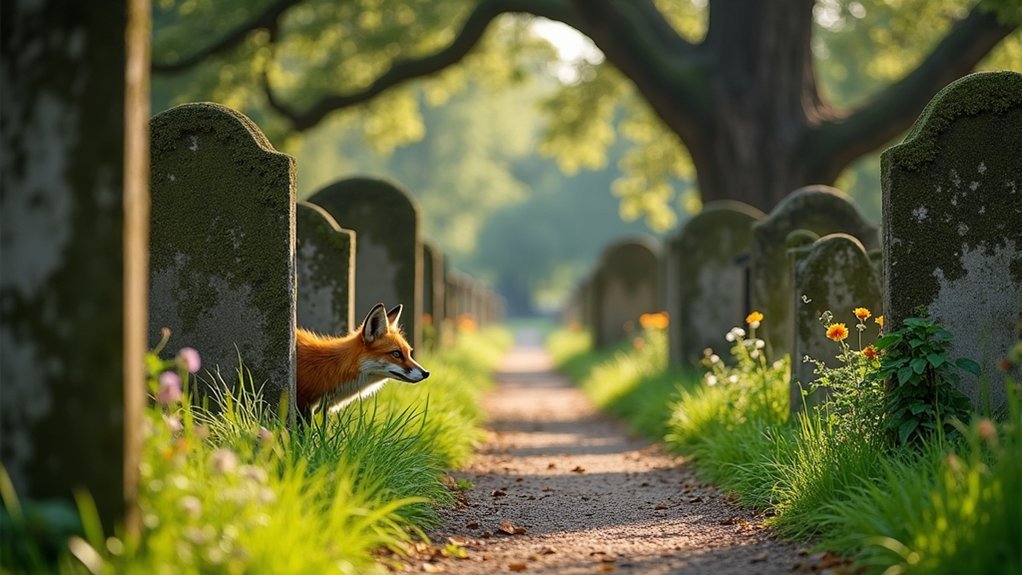
How can you respectfully document the diverse wildlife that inhabits historic cemeteries? Time your visits during early morning or late afternoon when wildlife is most active and lighting is soft. Use a zoom lens to photograph animals without disturbing their natural behavior in these sacred spaces.
| Technique | Equipment | Benefit |
|---|---|---|
| Morning/evening shoots | Camera with low-light capability | Golden hour lighting on wildlife |
| Natural feature focus | Zoom lens (70-300mm+) | Captures context without disturbance |
| Patient observation | Portable seat/tripod | Allows wildlife to acclimate to your presence |
| Path adherence | Comfortable walking shoes | Minimizes habitat disruption |
Remain quiet and still, allowing animals to resume their natural behaviors. By focusing on trees and shrubs that attract wildlife while staying on designated paths, you’ll capture stunning photos while respecting the cemetery’s sacred nature.
Birding Equipment Essentials for Cemetery Tours
To fully appreciate the rich avian diversity that thrives in historic cemeteries, you’ll need a few key pieces of equipment that balance functionality with respect for these sacred spaces.
Opt for binoculars with 8x to 10x magnification, providing ideal detail without sacrificing your field of view. Carry a birding journal to record sightings and behaviors, creating a personal record of your cemetery wildlife encounters.
- Download a bird identification app or bring a field guide for quick species recognition
- Choose binoculars with appropriate magnification for both distant and nearby observations
- Pack a lightweight backpack for your gear, water, and snacks
- Wear neutral-colored, breathable clothing that won’t disturb wildlife
- Bring a birding journal to document sightings and create a lasting memory of your experience
Connecting Conservation and Commemoration
When you visit historic cemeteries like Glenwood, you’re entering shared sanctuary spaces where human history and natural ecosystems converge in remarkable harmony.
These memorials nurture nature by providing protected green spaces where wildlife thrives undisturbed amid the monuments and markers of those who came before us.
Your appreciation of both conservation and commemoration creates a powerful connection to dual heritage preservation, honoring both the cultural significance of these sites and their ecological value to our communities.
Shared Sanctuary Spaces
Historic cemeteries serve as more than final resting places for the departed; they’ve evolved into vibrant ecosystems where conservation and commemoration naturally intertwine.
When you visit these shared sanctuaries, you’ll experience spaces where humans and wildlife coexist in remarkable harmony.
Community involvement in preserving these grounds strengthens conservation efforts while honoring our collective heritage.
The wildlife habitats found within cemetery boundaries offer glimpses of nature’s resilience amid urban development.
- Birds nesting in century-old trees above historic monuments
- Butterflies pollinating native flowers planted alongside gravestones
- Small mammals finding refuge among carefully maintained greenspaces
- Seasonal changes bringing new wildlife visitors throughout the year
- Quiet pathways allowing for mindful observation of species rarely seen elsewhere
These sanctuaries invite you to witness the delicate balance between remembrance and renewal.
Memorials Nurture Nature
Nestled among weathered headstones and historic monuments, thriving ecosystems demonstrate how memorials and nature support each other in perfect harmony.
You’ll discover that these sacred grounds aren’t just resting places for the departed but sanctuaries where conservation flourishes alongside commemoration.
As you wander through places like Glenwood Cemetery, you’ll notice how diverse tree species, flowers, and shrubs don’t just beautify the grounds—they create essential habitats for local wildlife.
The memorials themselves often serve as perches for birds or shelter for small creatures.
Educational tours highlight this delicate balance, showing how preservation efforts protect both cultural heritage and ecological integrity.
Dual Heritage Preservation
The preservation of historic cemeteries represents a rare partnership between nature and history that you won’t find elsewhere.
When you support these sacred grounds, you’re simultaneously contributing to wildlife conservation and historical commemoration. These dual-purpose sanctuaries invite community engagement through educational tours that highlight both ecological and cultural significance.
- Observe how memorial landscapes create essential habitats for local wildlife
- Learn about native species that have found refuge among historic headstones
- Discover how conservation efforts enhance rather than compete with commemoration
- Connect with your community’s past while supporting its ecological future
- Participate in preservation initiatives that honor both human and natural history
Best Times of Day for Wildlife Observation in Cemeteries
When planning your cemetery wildlife tour, timing is everything for ideal animal sightings. Early mornings offer prime wildlife observation opportunities as birds begin their daily foraging and small mammals emerge from nighttime hiding spots.
The cooler dawn temperatures in cemeteries create perfect conditions for active wildlife.
You’ll find a similar surge of activity during late afternoons when the day cools again. At Glenwood Cemetery and similar green spaces, these changing hours reveal squirrels gathering food and birds settling in for evening routines.
Creating a Cemetery Wildlife Journal
While timing your visits can maximize wildlife sightings, capturing these experiences through documentation will enrich your cemetery explorations. A Cemetery Wildlife Journal becomes your personal record of biodiversity encountered during historic cemetery tours, connecting you to both history and nature.
- Record species names, behaviors, and locations to track patterns across seasons.
- Include sketches or photographs of wildlife encounters to enhance your journal.
- Note interactions between species and their cemetery habitat.
- Document how wildlife utilizes historical structures within the grounds.
- Track rare or unexpected sightings to contribute to citizen science initiatives.
Your journal transforms casual observations into meaningful data, preserving your experiences while potentially contributing to local conservation efforts.
You’ll develop a deeper appreciation for how these sacred spaces serve as refuges for urban wildlife.
Ethical Guidelines for Wildlife Watching in Memorial Grounds
Since historic cemeteries serve as both memorial spaces and wildlife sanctuaries, your approach to wildlife observation requires special consideration.
Always maintain a respectful distance from wildlife to minimize disturbance, allowing animals to behave naturally while preserving the cemetery’s tranquil atmosphere.
Stay on designated paths when exploring to protect both the delicate ecosystem and burial sites. This simple practice prevents damage to native flora that provides habitat for the wildlife you’ve come to appreciate.
Never feed the animals you encounter, as this creates unhealthy dependencies and disrupts natural behaviors.
Keep noise to a minimum and avoid sudden movements that might startle creatures.
Remember to take all trash with you—litter threatens wildlife and diminishes the cemetery’s historical dignity.
How Cemetery Greenspaces Support Urban Wildlife Corridors
Historic cemeteries serve as significant greenspace sanctuaries amid concrete jungles, creating fundamental wildlife corridors that connect otherwise fragmented natural habitats throughout urban environments.
When you visit these peaceful grounds, you’re walking through important ecological passages that allow animals to navigate the city safely.
- Trees, shrubs, and flowering plants provide food sources and shelter for diverse species.
- Strategic locations of historic cemeteries create stepping stones for wildlife movement across urban areas.
- Mature landscaping offers nesting sites for birds and small mammals rarely found elsewhere in cities.
- Pollinator-friendly vegetation supports bees and butterflies crucial to urban ecosystem health.
- Undisturbed grounds provide consistent habitat in otherwise rapidly changing urban environments.
Your cemetery visits support preservation efforts that maintain these irreplaceable wildlife corridors for generations to come.
Frequently Asked Questions
What Is the Purpose of the Visit to the Cemetery?
You’ll visit the cemetery to connect with local history, learn about those interred, appreciate architectural styles, enjoy natural landscapes, and reflect in a tranquil environment. It’s a meaningful way to explore heritage.
Why Are Cemeteries Important to History?
Cemeteries are important to history because they’re tangible archives of your community’s past. You’ll find genealogical records, artistic expressions, and cultural practices preserved there, offering you direct connections to previous generations and their stories.
In Summary
When you’re wandering among the tombstones, you’re not just connecting with history—you’re stepping into a thriving wildlife sanctuary. You’ll discover that cemeteries offer unique opportunities to witness nature’s resilience in urban settings. Keep your eyes open, maintain respectful distances, and you’ll find that these peaceful resting places are actually vibrant with life, teaching us that death and rebirth exist in perfect harmony all around us.

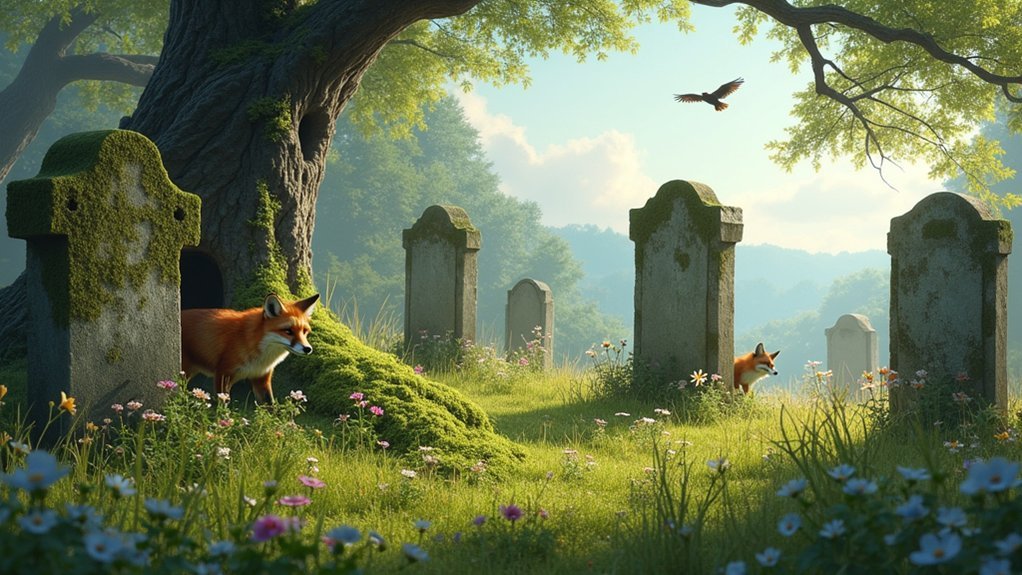


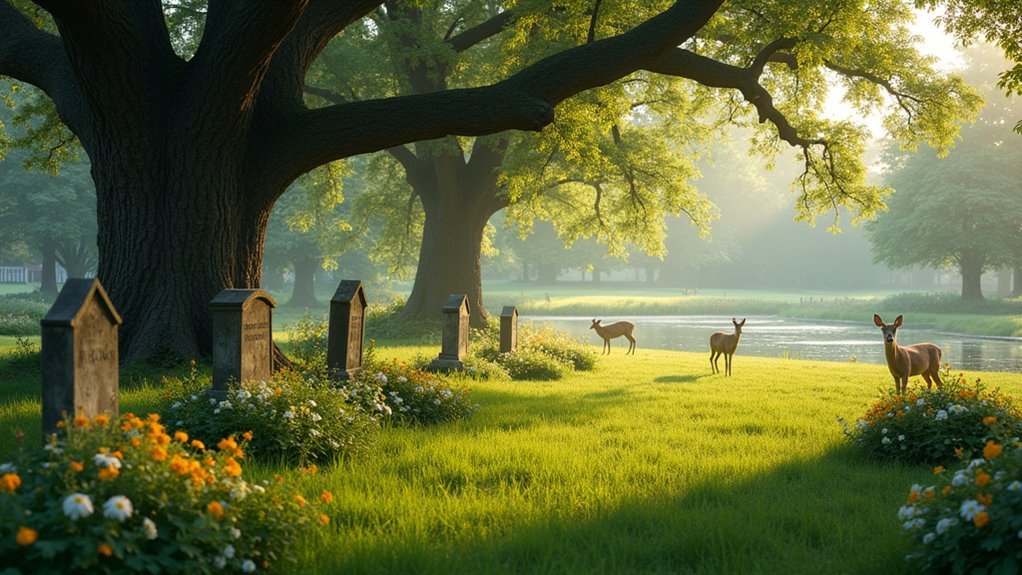
Leave a Reply